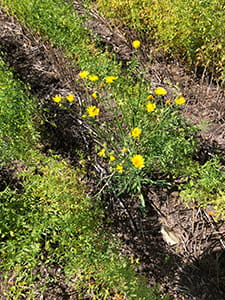By Shawna Williams, Summer Student, Yorkton
Narrow-leaved hawk’s beard is an introduced weed that is widespread in Saskatchewan cereal and oilseed crops, as well as perennial forages, but is most aggressive in the northwest of the province. Narrow-leaved hawk’s beard can behave as a summer or winter annual, with the winter annual form posing the largest threat. Its low rosette protects the plant from low temperatures, drying wind and uses snow cover as insulation to thrive over germinating annual crops in the spring. This weed has increasingly become a problem in relation to reduced tillage practices on the prairies, resulting in less disruption to its life cycle and growth patterns.

full flowering stage
Narrow-leaved hawk’s beard has a deep taproot and can quickly reproduce by seed. Its cotyledons are oval to oblong and flowers are bright yellow. The plant’s leaves contain a milky-white sap visible when the leaves are torn. Germination and emergence can occur throughout the growing season, with little dormancy and can remain viable in the soil for up to five years. This growth characteristic makes early control measures in annual cropping systems essential.
At the seedling and rosette stage, narrow-leaved hawk’s beard can be difficult to tell apart from dandelions, but a key difference is that dandelion leaves are a darker green colour. It can also be confused with the native smooth hawk’s beard. However, the smaller, hairless flower heads found on smooth hawk’s beard can help distinguish one from the other. Smooth or green hawk’s beard is larger and more robust looking, but narrow-leaved hawk’s beard is more competitive from the densities it grows in.

A good strategy to prevent yield loss in annual crops is to use integrated weed management to prevent seed production and establishment of the weed on cropland. For more information on controlling this weed, consult the Guide to Crop Protection to see registered herbicides for the crop you are growing. Be sure to scout your fields early to have the best chance of controlling any weed problems. If you suspect a herbicide-resistant population, a sample of the seed can be sent to the Crop Protection Laboratory for testing.
For more information, contact your local crops extension specialist or call the Agriculture Knowledge Centre’s general inquiry line, toll-free at 1‑866‑457‑2377.
